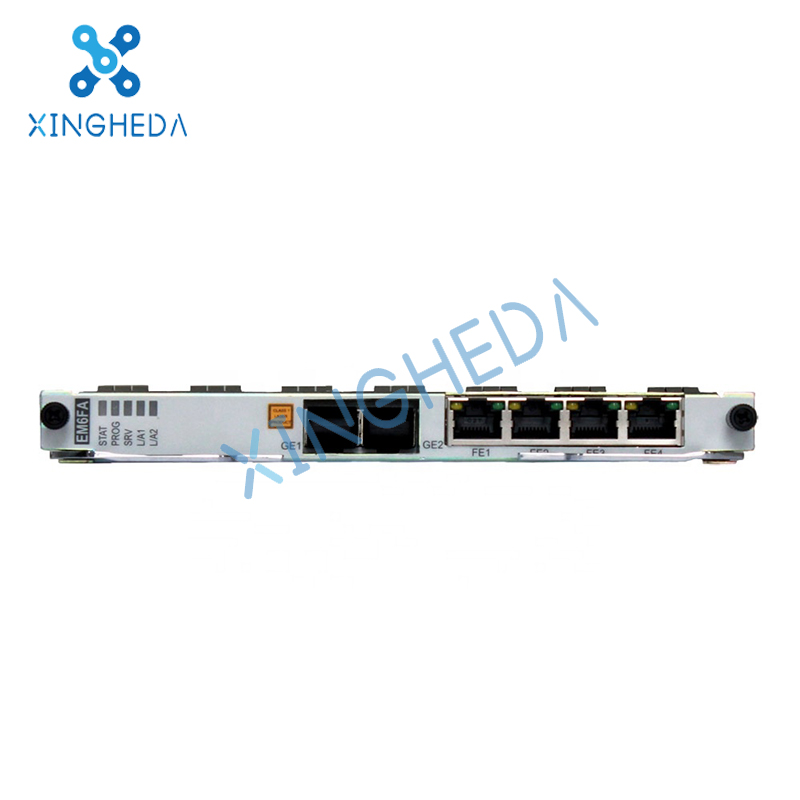Xinghe Da Technology Co., Ltd
Contacts:Jack Peng
Mobile:+86 18627553022
Whatsapp:+86 18627553022
WeChat: pengyi-changsha
E-mail:admin@chinaxingheda.com
Company address :2506 Xidi Building, No. 8 Fenglin Third Road, Yuelu District, Changsha City, Hunan Province
OLT,XPON-HUAWEI EM6 SL91 4-port RJ45SFP+2-port RJ45 Fast EthernetGigabit Ethernet interface board
Version Description
The functional version of an EM6 board is SL91
Application
EM6 boards can be used to receive and transmit GE FE services or carry Multiprotocol Label Switching (MPLS) tunnels
Receiving and Transmitting Ethernet Services
When OptiX RTN 980 uses Integrated IP microwave to transmit Ethernet
Product Details:
Version Description
The functional version of an EM6 board is SL91.
Application
EM6 boards can be used to receive and transmit GE/FE services or carry Multiprotocol Label Switching (MPLS) tunnels.
Receiving and Transmitting Ethernet Services
When OptiX RTN 980 uses Integrated IP microwave to transmit Ethernet services, EM6 boards can be used to receive and transmit GE/FE services. The FE/GE services may be from client equipment or Layer 2 networks.
Figure 1 Application scenario for EM6 boards to receive and transmit GE/FE services
NOTE:
IF boards shown in the preceding figure must be common IF boards or XPIC IF boards working in native E1+Ethernet mode or native STM-1+Ethernet mode.
In the preceding figure, if being transmitted over Integrated IP microwave, Ethernet services can be native Ethernet services or ETH pseudo wire emulation edge-to-edge (PWE3) services.
System control boards can be CSHNA or CSHNU.
Carrying MPLS Tunnels
EM6 boards can carry MPLS tunnels to allow MPLS or PWE3 services to traverse microwave networks and local backhaul networks. In this way, E2E transmission is achieved..
Figure 2 Application scenario for EM6 boards to carry MPLS tunnels
NOTE:
IF boards shown in the preceding figure must be common IF boards or XPIC IF boards working in native E1+Ethernet mode or native STM-1+Ethernet mode.
If required, two MPLS tunnels can be created on both the packet microwave network and local backhaul network so that PWE3 services are transmitted on multi-segment pseudo wires (MS-PWs) in end-to-end mode.
Service boards shown in the preceding figure can be Smart E1 processing boards or Ethernet interface boards.
System control boards can be CSHNA or CSHNU.
Functions and Features
EM6 boards receive/transmit, process, and converge 4xGE+2xFE service signals. They also can receive/transmit 4xFE optical signals using FE SFP optical modules installed at their SFP ports.
Table 1 lists the functions and features supported by EM6 boards. EM6 boards implement Ethernet service functions by working with packet switching units on the system control, switching, and timing boards.
Table 1 Functions and features that EM6 boards support
Working Principle and Signal Flow
This section describes how the function units of an EM6 board process GE/FE signals.
Function Block Diagram
Figure 1 EM6 board function block diagram
The functional version of an EM6 board is SL91.
Application
EM6 boards can be used to receive and transmit GE/FE services or carry Multiprotocol Label Switching (MPLS) tunnels.
Receiving and Transmitting Ethernet Services
When OptiX RTN 980 uses Integrated IP microwave to transmit Ethernet services, EM6 boards can be used to receive and transmit GE/FE services. The FE/GE services may be from client equipment or Layer 2 networks.
Figure 1 Application scenario for EM6 boards to receive and transmit GE/FE services
NOTE:
IF boards shown in the preceding figure must be common IF boards or XPIC IF boards working in native E1+Ethernet mode or native STM-1+Ethernet mode.
In the preceding figure, if being transmitted over Integrated IP microwave, Ethernet services can be native Ethernet services or ETH pseudo wire emulation edge-to-edge (PWE3) services.
System control boards can be CSHNA or CSHNU.
Carrying MPLS Tunnels
EM6 boards can carry MPLS tunnels to allow MPLS or PWE3 services to traverse microwave networks and local backhaul networks. In this way, E2E transmission is achieved..
Figure 2 Application scenario for EM6 boards to carry MPLS tunnels
NOTE:
IF boards shown in the preceding figure must be common IF boards or XPIC IF boards working in native E1+Ethernet mode or native STM-1+Ethernet mode.
If required, two MPLS tunnels can be created on both the packet microwave network and local backhaul network so that PWE3 services are transmitted on multi-segment pseudo wires (MS-PWs) in end-to-end mode.
Service boards shown in the preceding figure can be Smart E1 processing boards or Ethernet interface boards.
System control boards can be CSHNA or CSHNU.
Functions and Features
EM6 boards receive/transmit, process, and converge 4xGE+2xFE service signals. They also can receive/transmit 4xFE optical signals using FE SFP optical modules installed at their SFP ports.
Table 1 lists the functions and features supported by EM6 boards. EM6 boards implement Ethernet service functions by working with packet switching units on the system control, switching, and timing boards.
Table 1 Functions and features that EM6 boards support
| Function and Feature | Description | |
| Basic functions | Receives/Transmits GE/FE service signals, and processes these signals by working with the packet switching unit. | |
| Port specifications | Ethernet port | Provides six Ethernet ports. Provides two unpluggable FE electrical ports. Provides four unpluggable GE electrical ports or four SFP optical ports. Supports the following types of SFP modules: Dual-fiber bidirectional FE/GE optical module Colored CWDM GE optical module (CWDM stands for coarse wavelength division multiplexing) Single-fiber bidirectional FE/GE module |
| Backplane bus bandwidth | CSHN boards: 2.5 Gbit/s for slots 1 to 6 and 1 Gbit/s for slots 7 to 14 CSHNA boards: 2.5 Gbit/s for slots 1 to 2 and 1 Gbit/s for slots 3 to 14 CSHNU boards: 2.5 Gbit/s for slots 1 to 14 |
|
| Switching mode | Centralized mode NOTE: When a board works in centralized mode, all Ethernet services carried on the board must be forwarded by the packet switching unit of the cooperating system control board. |
|
| Port attributes | Working mode | GE electrical ports support 10M/100M/1000M full-duplex and auto-negotiation. GE optical ports support 1000M full-duplex and auto-negotiation. FE electrical ports support 10M/100M full-duplex, and auto-negotiation. FE optical ports support 100M full-duplex. |
| Tag attributes | The tag attribute can be tag aware, access, or hybrid. Sets and queries the tag attribute of a port. |
|
| Jumbo frames | Supports jumbo frames with a maximum length of 9600 bytes. | |
| Traffic control | Supports port-based traffic control that complies with IEEE 802.3x. | |
| Services | Native Ethernet services | E-Line services Port-based E-line services VLAN-based E-line services E-Line services carried by QinQ links E-LAN services E-LAN services based on IEEE 802.1d bridges E-LAN services based on IEEE 802.1q bridges E-LAN services based on IEEE 802.1ad bridges |
| PWE3 Ethernet services | E-Line services carried by PWs E-Aggr services carried by PWs E-LAN services carried by PWs, that is, virtual private LAN services (VPLSs) |
|
| Link aggregation group (LAG) | Inter-board LAG | Supported |
| Intra-board LAG | Supported | |
| Ethernet ring protection switching (ERPS) | Supported (complies with ITU-T G.8032 v1/v2) | |
| MPLS functions | Refer to the description of MPLS/PWE3 functions provided in the sections about system control, switching, and timing boards. | |
| PWE3 functions | ||
| Spanning Tree Protocol (STP) | Supports Multiple Spanning Tree Protocol (MSTP) that runs only Common and Internal Spanning Tree (CIST) instances. This type of MSTP provides the same functions as Rapid Spanning Tree Protocol (RSTP). | |
| IGMP snooping | Supported | |
| Link-state pass through (LPT) | Supported | |
| Port mirroring | Supported | |
| LLDP | Supported | |
| Quality of service (QoS) | DiffServ | Supports simple traffic classification by specifying per-hop behaviors (PHBs) based on packets-carried QoS information (including C-VLAN priority, S-VLAN priority, DSCP value, and MPLS EXP value). |
| Complex traffic classification | Supports traffic classification based on the following information carried by packets: SMAC, DMAC, C-VLAN IDs, S-VLAN IDs, C-VLAN priorities, S-VLAN priorities, C-VLAN IDs + C-VLAN priorities, S-VLAN IDs + S-VLAN priorities, or DSCP values. | |
| Committed access rate (CAR) | Provides the CAR processing for traffic flows at ports. | |
| Shaping | Supports traffic shaping for a specific port, prioritized queue, or traffic flow. | |
| Queue scheduling policies | Strict-priority (SP) Weighted round robin (WRR) SP+WRR |
|
| Congestion avoidance | Supports tail drop and weighted random early detection (WRED). | |
| Traffic shaping | Supports shaping for a specified port, priority queue, or service flow, and allows the peak information rate (PIR) and committed information rate (CIR) to be modified in 64 kbit/s steps. | |
| ETH OAM functions | Ethernet service OAM | Supports ETH OAM functions that comply with IEEE 802.1ag. Supports frame loss measurement, frame delay measurement, and delay variation measurement functions that comply with ITU-T Y.1731. |
| Ethernet port OAM | Supports ETH OAM functions that comply with IEEE 802.3ah. | |
| Remote network monitoring (RMON) | Supported | |
| Clock | Physical layer synchronization | Synchronous Ethernet |
| Physical-layer clock protection | Protection implemented based on different clock source priorities Protection implemented by running the Synchronization Status Message (SSM) protocol Protection implemented by running the extended SSM protocol |
|
| Packet time synchronization | Supports IEEE 1588v2 time synchronization. Supports ITU-T G.8275.1 time synchronization. Supports use of the AE 905S module as the clock source for time synchronization. |
|
| Packet frequency synchronization | Supports IEEE 1588v2 frequency synchronization. Supports IEEE 1588 ACR. |
|
| Data communication network (DCN) | Inband DCN | Each port provides one inband DCN channel. |
| Operation and management | Loopback | Supports inloops at the PHY layer of Ethernet ports. Supports inloops at the MAC layer of Ethernet ports. |
| Warm and cold resetting | Supported | |
| Manufacturer information query | Supported | |
| Power consumption query | Supported | |
| Voltage monitoring | Supported | |
| Temperature monitoring | Supported | |
| SFP module information query | Supported | |
Working Principle and Signal Flow
This section describes how the function units of an EM6 board process GE/FE signals.
Function Block Diagram
Figure 1 EM6 board function block diagram
A Free Consultation
You can contact us any way that is convenient for you. We are available 24/7 via fax, email or telephone.


